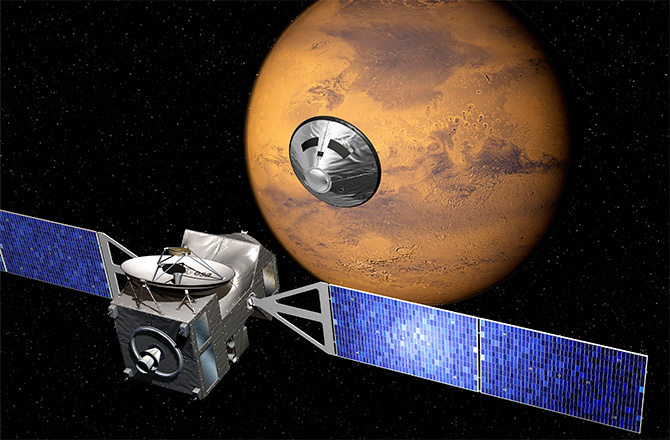ExoMars Mission Will Arrive on Time, Despite Hiccup

Earlier this month, the ExoMars launch date was pushed back by a couple of months. Instead of launching in January 2016, the European mission will launch the following March -- but still get to Mars at nearly the same time. How is this possible?
PHOTOS: Watching the Sunsets of Mars Through Robot Eyes
The 2016 portion of the ExoMars mission is composed of the Trace Gas Orbiter (TGO), a satellite that will examine the composition of Mars' atmosphere, and a small lander called Schiaparelli that will test landing technologies. It's a technical problem with Schiaparelli that is causing the holdup, specifically focused around two measurement devices that monitor how fuel is being pressurized during landing. [Europe's ExoMars Mission in Pictures]
"Recently the manufacturer (Moog Bradford) was looking into their past manufacturing records and various data, and they’ve discovered, based on some tests, that the process isn’t what it should have been. They could have cracks in the devices," Don McCoy, ExoMars project manager, told Discovery News.
So Liquid Water Flows on Mars -- Now What?
The devices are not required for the landing, but just collect more data, he added; hence the decision to take them out.
While the discovery was unexpected, the ExoMars team built some "slack" into the schedule for problems, McCoy said. Mars and Earth will move closer together between the prime launch window in January (7th to 27th) and the new launch window in March (14th to 25th). It is probable that ExoMars will need to fire its engine longer (burning more fuel), after it loops around the sun, to arrive there as planned in October 2016.
Get the Space.com Newsletter
Breaking space news, the latest updates on rocket launches, skywatching events and more!
The potential cracks could have caused a fuel leak and as such, the measurement devices were removed completely in a process that took about three weeks (including disassembling the spacecraft, carefully removing the devices and doing checks, and reassembling).
NEWS: Possible Landing Sites Selected for Europe's ExoMars
There are several other missions that were supposed to use these devices; McCoy didn't specify which missions, but said these missions were not as developed as ExoMars and it will be easier to deal with the problem.
After arrival, the TGO will remain at Mars to serve as a communications relay for the ExoMars 2018 rover, and has a prime mission of five years. Schiaparelli is expected to land in Meridani Planum roughly three days before TGO arrives at Mars. It will only operate for a short time on the surface before its batteries die.
This article was provided by Discovery News.
Join our Space Forums to keep talking space on the latest missions, night sky and more! And if you have a news tip, correction or comment, let us know at: community@space.com.

Elizabeth Howell (she/her), Ph.D., was a staff writer in the spaceflight channel between 2022 and 2024 specializing in Canadian space news. She was contributing writer for Space.com for 10 years from 2012 to 2024. Elizabeth's reporting includes multiple exclusives with the White House, leading world coverage about a lost-and-found space tomato on the International Space Station, witnessing five human spaceflight launches on two continents, flying parabolic, working inside a spacesuit, and participating in a simulated Mars mission. Her latest book, "Why Am I Taller?" (ECW Press, 2022) is co-written with astronaut Dave Williams.









